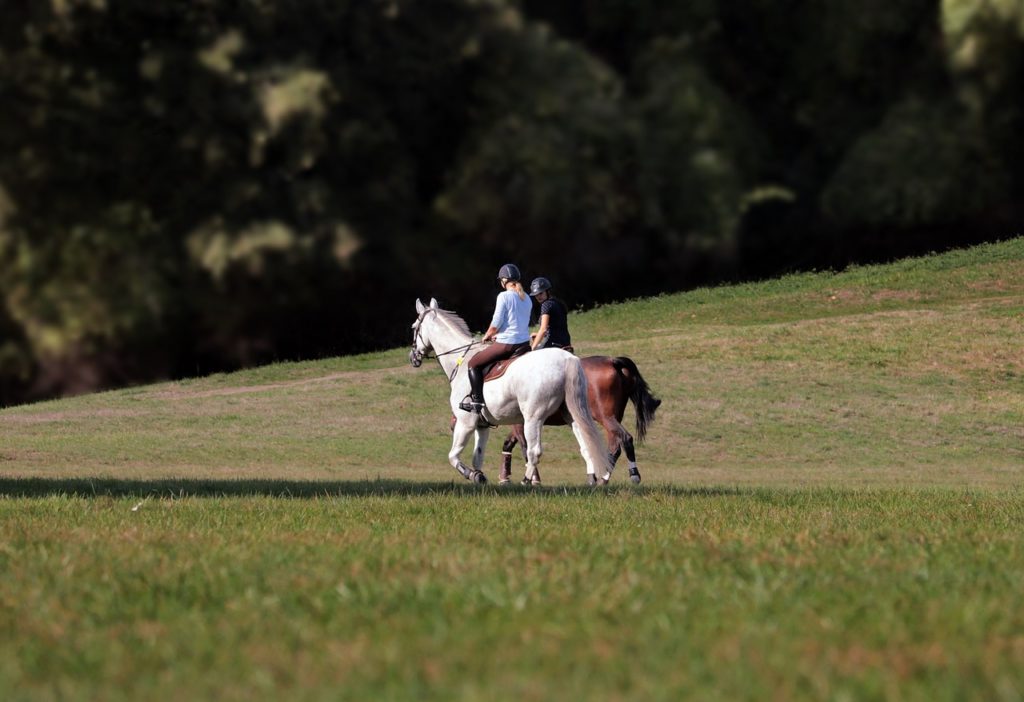If you have given your equine partner a break over the cold winter months (or over the coronavirus pandemic lockdown months), or turned them away to allow an injury to fully heal, perhaps you have taken his shoes off, adjusted management schedules and exercise routines. This can result in your horse losing his level of fitness, and most probably an increase in weight.
You might be tempted to bring your beloved equine partner in from the field, tack up and head off on your first ride, the truth is that this is the perfect recipe for disaster. It would be terrible to have to spend more time off riding because of an injury or accident that could easily be prevented.
Bringing your horse back into work after a period of time off such as the lockdown caused by the COVID-19 pandemic takes some planning to make sure both rider and horse come back into work safely and guarantee you’re following best practice when it comes to our horse’s wellbeing.
It is truly important to follow your vet’s advice if you are actually bringing your equine partner back into work from a serious injury, in order to prevent any further damage being caused.
Injuries happen constantly, and getting your equine partner back into work right away will depend on implementing a proper recovery program including the necessary equine rehabilitation equipment. It doesn’t really matter if you are a new horse owner of a rescue horse, a qualified horse caretaker, or anything in between: the challenges of rehabilitating an injured horse are always daunting. We’re talking about a long process here, and it requires a proper commitment of both financial resources and time. Having a clear vision of what you should do and what you shouldn’t can really improve your horse’s chance for a full recovery.
Preparation
- It doesn’t really matter how fit your equine partner was prior to being turned away, your horse will definitely lose conditioning.
- Any weight gain actually means a strain on muscles, joints, tendons and cardiovascular system is highly likely. This needs to be at the forefront of our minds when our horse returns to work.
- Changes to his routine need to be done gradually.
- Keep in mind that returning your equine partner from grass to top-level fitness might take about two months, even longer depending on your horses’ age, type, weight and previous health conditions.
Bring a youngster back into work
One of the most important aspects to keep in mind when bringing any horse back into work is to carry out a full health check before anything else – such check needs to include checking their teeth, feet and tack. Checking tack and teeth is important with youngsters as they can grow and therefore change shape quickly. You don’t want your young horse to associate work with discomfort or pain, so ensure that everything fits adequately and that the experience is positive.
Bring your horse back into work after rehab
When you bring your horse back into work after a rehabilitation process from a serious injury, it’s important to check they are totally ready to start working again. Make sure your horse is fully recovered from the injury. If you are still unsure, get in touch with a specialist – it is definitely better to start off on the right foot, even if it requires some external assistance, than trying to resolve new issues further down the line.
What you should do to guarantee a full recovery after the injury
Do create a list of reliable specialists: it is key to foster a solid relationship with your vet. When dealing with an injury that requires an ongoing rehab process, make sure you keep open the lines of communication. Most vets will be more than happy to discuss your horse’s prognosis and treatment plans with you. Having a thorough plan will help get some peace of mind, and will allow you to stay focused on a positive outcome.
Do create a healing space: while your equine partner recovers, make sure you provide an environment that facilitates healing. In case your injured equine partner is confined to stall rest, go ahead and relocate him to a quiet dust-free stall that offers safe footing. Make sure the horse is comfortable, provide extra cushioning if needed. Be careful when it comes to stall cleanliness to avoid infections and the build-up of bacteria from dirty bedding.
Do monitor your equine partner’s progress: it is vital to stay up-to-date when it comes to your horse’s healing journey. Follow-up appointments with your vet should include diagnostic monitoring, depending on the type of injury.
Warm up and cool down
Warming up and cooling down are parts of the process that need to be carried out with special care, whether you are bringing our equine partner back into work, or just on a day to day basis. They are of the utmost importance in order to keep your horse fit and muscle tone elastic and to eventually prevent injuries to tendons and ligaments.
Ongoing evaluations
Fitness work can be carried out around fields, in an arena or out hacking, depending on the type of premises you can use. It is actually important to be mindful of the ground conditions you are riding on since this can impact your equine partner’s physical wellbeing. Has it been raining excessively? Is the ground actually hard? Constantly evaluate your equine partner’s recovery times. In case you need to extend your walking weeks, go ahead and do so. Slow work in the beginning will lay down the foundations for faster work afterwards and will definitely minimise the risk of new injuries.


